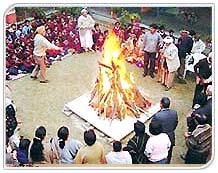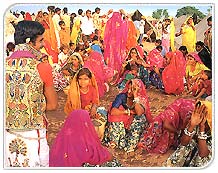Cultural India
Cultural India Home » People » History » National Anthem » National Animal » National Tree » Fairs & Festivals
Physical Features » National Emblems » National Bird » National Fruit » Religions » Languages
National Flag » National Flower » Air Line Ticketing » Map of India » Travellers Tools
---------------------------------------------------------------------------------------------------------------------------------------------------------------------------------------------------------------------------------
Fairs & Festivals
September | October | November | December
January Fairs & Festivals
MAKAR SANKRANTI

(Maharashtra,
Karnataka & Andhra Pradesh)
Is a celebration of spring on the occasion of the 'ascent' of the sun to the
north (Uttarayana). In Maharashtra, Karnataka as well as part of Andhra, Maker
Sankranti is a day of goodwill and friendship. Seasome ladoos and suger drops
are distributed as a symbol of the need to be generous and kind to everyone.
Women wear new clothes, new glass bangles and hold get-togethers to share
sweets and gifts. A new bride is given ornaments made of sugar drops and her
new relatives are inivited to meet and welcome her at a Haldi Kumkum celebration.
LOHRI
(Punjab)
In the North Makar Sankranti is called Lohri. It is the only Hindu festival
which falls regularly on the 14th of January every year. Lohri is the time
after which the biting cold of winter begins to taper off. On this day the
children go from door to door to collect founds for community bonfires which
are lit in the evening. Lohri is more of a community festival, where the birth
of a son or the first year of marriage is celebrated with great fun and frolic.
People gather around the bonfires and offer sweets, crisp rice and popcron
to the flames. Songs are sung to the beat of vigorous claps and greetings
are exchanged.
PONGAL
(Tamil Nadu, Andhra Pradesh)
In the South Sankranti becomes Pongal. It is a celebration of the harvest
which is observed for three days in Tamil Nadu as well as in Andhra Pradesh.
The first day is the Bhogi Pongal which is celebrated as a family festival.
Surya Pongal, the second day, is dedicated to the Sun (surya) when pongal
(rice cooked in milk and jaggery) is boiled by women and offered to the sun.
Friends greet one another by asking "Is it boiled?" and the answer
given is "It is". It is followed by great rejoicing. Mattu Pongal,
the third day, is a day dedicated to the worship and veneration of cattle(mattu).
The pongal that has been offered to the local deities is given to the cattle
to eat. The cattle are bathed and decorated. Coloured balls of the pongal
are also made and left in the open for birds. In Madurai, Tiruchirapalli and
Tanjore, a kind of bullfight, called the "Jellikattu" is held. Bundles
containing money are tied to the horns of ferocious bulls, and unarmed villagers
try to wrest the bundles from them. With ingredients provided by the freshly
gathered harvest, community meals are held at night.
THAI PUSAM
(Tamil Nadu)
This festival usually takes places in the temples dedicated of Kartikeya or
Mariamman where trenches of burning coal are laid out for the devotes to walk
over. It has been seen that people who volunteer to undertake this experience
with faith, come away unharmed and unscathed. The chief priest of the temple
and the twelve "hero-youths", who are to perform this feat, first
go out in a procession from the temple to bathe, smear themselves with turmeric,
powder, and begin and dance. Then they walk over a long pit covered with burning
coals and come out unscathed. This is followed by singing and feasting which
continues till late night.
FLOAT FESTIVAL
(Tamil Nadu)
This magnificent festival is celebrated in Madurai on the night of the full
moon. The ornamented icons of the two deities, the God Sundaresa (incarnation
of Shiva) and the Goddess Meenakshi (incarnation of Parvati), with pearl crowns
on their heads and riding on a golden bull are taken out in a splendid procession
from the Meenakshi temple. The God Alagar (incarnation of Vishnu) gives his
sister Meenakshi, in marriage to Sundaresa amidst great rejoicing. Devotes
clothed in yellow and red dance among the processionists and spray coloured
water on them. The icons are floated in the tank on a raft decked with flowers
and flickering lamps.
NATIONAL KITE FESTIVAL
In Gujarat and other western states the change in the direction of winds on
Makar Sankranti is marked by thousands of colourful kites of all patterns
and dimensions which dot the blue sky. Young men vie with each other to win
community kite-flying competitions. The kites are hand made and the thread
is given a coating of glass powder mixed in either resin or a paste made of
refined wheat flour. The day also witnesses kite flying tournaments in which
handsome cash, cups and shields are awarded as prizes to the winners. Special
kites with paper lamps fill the night sky with myriad flickering lights.
KERALA VILLAGE FAIR
Mid -January is the time for cultural events in the lush villages around Kovalam,
every year. Traditional thatch houses are decorated during this ten day long
festival and are the venue for folk dances, music and festivites.
 BIKANER
FESTIVAL
BIKANER
FESTIVAL The festival starts off with a magnigicent procession of bedecked camels. It is a colourful spectacle of beautifully decorated camels that fascinates the onlookers with their charm and grace. Several competitions are held, marked with typical Rajasthani colour, joyous music and lilting rhythms and gay festivities.
PATTADAKAL DANCE FESTIVAL
Is a festival of dance held at Pattadakal (karnataka), the ancient capital of the Chalukyan kings.
ID-UL-FITTR
(All over India) Celebrates the end of Ramzan, the Muslim month of fasting.
It is an occasion of feasting and rejoicing. The faithful gather in mosques
to pray, friends and relatives meet to exchange greetings. Prayers, family
get-togethers and feasts are the major highlights of the celebrations. Idi
or present of money are given to the youngsters by the family elders, conveying
their blessings.
VASANT PANCHAMI
(North India and West Bengal) Is a ceremonical welcome to spring on the fifth day of the waxing moon of Magh, when Saraswati, Shiva-Durga and Vishnu-Lakshmi are worshipped. People wear colourful attires, especially in bright shades of yellow and they dance, sing and make merry. In West Bengal, 'Saraswati'-the Goddess of learning is worshipped. The festival is celebrated with great fervour in the university town of Shantiniketan.
Physical Features » National Emblems » National Bird » National Fruit » Religions » Languages
National Flag » National Flower » Air Line Ticketing » Map of India » Travellers Tools